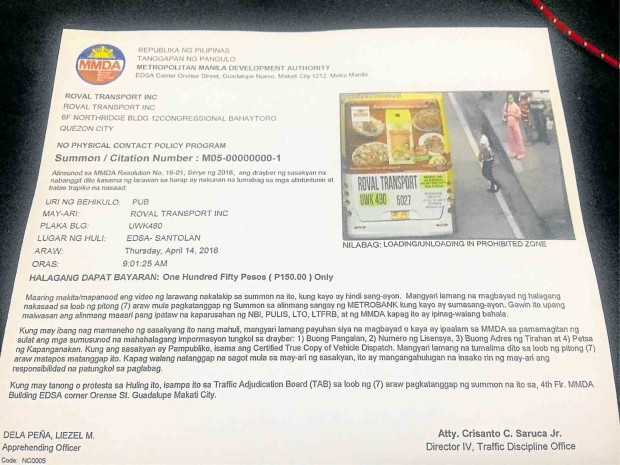No stopping ‘no-contact’ policy today

LETTER FROM ‘BIG BROTHER’ A sample of the summons to be sent by the MMDA to the owner or driver of the vehicle cited for a traffic violation and recorded by any of the more than 650 cameras set up by the agency on major thoroughfares across the capital. Maricar B. Brizuela
“Huli ka (Gotcha)! You’re on CCTV camera.”
It’s the tagline used by the Metropolitan Manila Development Authority (MMDA) to underscore the relaunch today of the “no-contact” apprehension policy, wherein hundreds of closed-circuit television cameras will be used to monitor traffic violations, track down erring motorists, and have them fined based on the video recordings.
The MMDA on Wednesday tweaked the procedures to give drivers “ample time to contest the infractions” for which they are cited under the system, which will apply to drivers of private or public utility vehicles (PUVs).
The agency also reminded the public that the CCTVs would only augment its traffic enforcers who would still be manning the streets and apprehend violators on site.
Motorists will be receiving summonses from the MMDA—via registered mail, courier service, or personal delivery by an MMDA employee—should they be caught on CCTV committing violations like reckless driving, illegal parking, loading and unloading in prohibited areas, illegally stopping within “yellow box” junctions, driving on the wrong lane (for buses and private vehicles), etc.
Article continues after this advertisementThe MMDA earlier said high-definition cameras would keep watch on the traffic flow and could clearly capture license plate markings that will be the agency’s basis for locating the address of vehicle owners. The cameras are expected to produce clear images taken even at nighttime.
Article continues after this advertisementSummons or notices will be sent to the vehicle’s owner or operator (in the case of PUVs) to identify the driver of the vehicle at the time the traffic violation was captured by the CCTV.
The notice will contain the date, time, location and type of traffic violation. It also informs the motorist that he or she has the right to contest the citation before the MMDA’s Traffic Adjudication Division (TAD) within seven days upon receipt of the summons.
Appeal can reach chairman
Within 15 days from receipt of an unfavorable TAD ruling, the driver may still file a motion for reconsideration (MR). If the MR is denied, the driver may further file an appeal in the Office of the Chairman, where the decision shall be final and executory.
If the citation goes uncontested at the TAD after the seven-day period, the MMDA will send a final notice to the owner or operator of the vehicle.
If the violator fails to pay the fine upon the receipt of the final notice, the MMDA will include the vehicle license plate in an “Alarm List” that will be forwarded to the Land Transportation Office (LTO). The driver will not be able to renew the vehicle registration at the LTO until the fines are settled.
650 cameras, 15 watchers
In an interview, MMDA Chair Emerson Carlos explained that there are certain violations that cannot be determined using cameras and thus still require traffic enforcers, like driving a “colorum” or a PUV that operates outside its approved route.
The no-contact policy will rely on about 650 CCTVs, of which 250 were recently installed. They will be keeping watch from strategic positions across the capital, especially on Edsa, C-5 Road, Roxas Boulevard, Commonwealth Avenue and Macapagal Avenue.
A 15-member team at the MMDA headquarters will be in charge of monitoring the CCTV footages for traffic violations, Carlos said.
The notices can reach the concerned operator or driver “in less than a week (from the day the violation was recorded) especially if they are residing in Metro Manila,” Carlos said.
‘We’re moving forward’
Asked if the agency is expecting additional workload especially for the adjudication division, TAD chief Joseph Salud said his office, which is composed of four hearing officers and two reviewers, is actually expecting the opposite.
“I think the no-contact policy will make our job easier since the evidence presented using videos and photos are clearer and more reliable,” Salud said, noting that previous cases were harder to resolve because the citations were not always supported by proper documentation.
Salud pointed out that a motorist can be cited for “multiple violations” within the same day under the no-contact policy if he or she disregards traffic rules in different locations. “But we will have to decide how many tickets will be given to the driver depending on the interval of these violations,” the lawyer said.
He defended the system as a step in the “positive direction,” noting that many developed countries has been using it for years. “Let us give it a chance because it is a sign that we are moving forward.”
The MMDA is actually reviving and expanding the no-contact policy that was first implemented for six months in 2009 during the chairmanship of Bayani Fernando, and again tested for six months in 2011 under the watch of Francis Tolentino, Carlos’ predecessor.